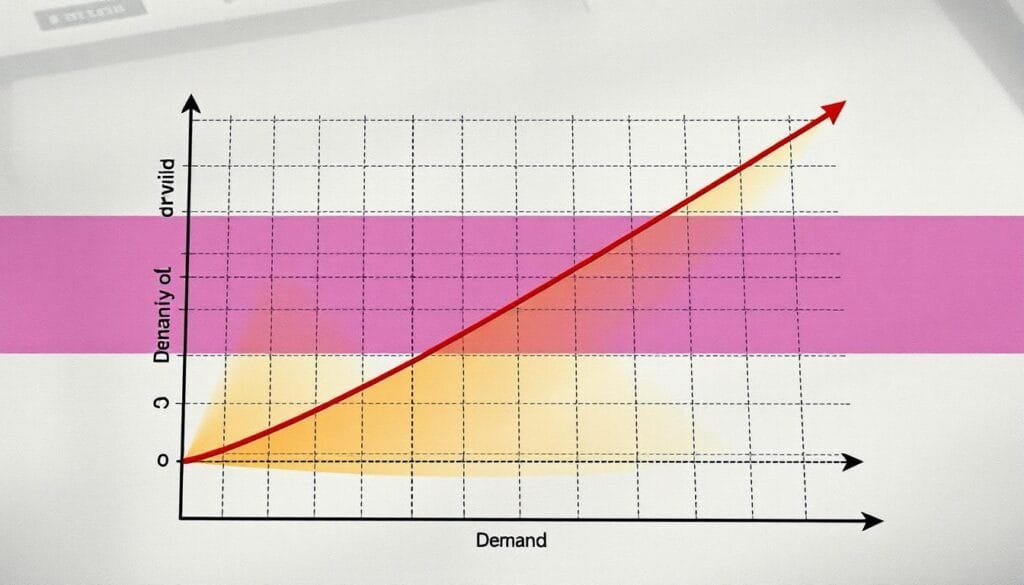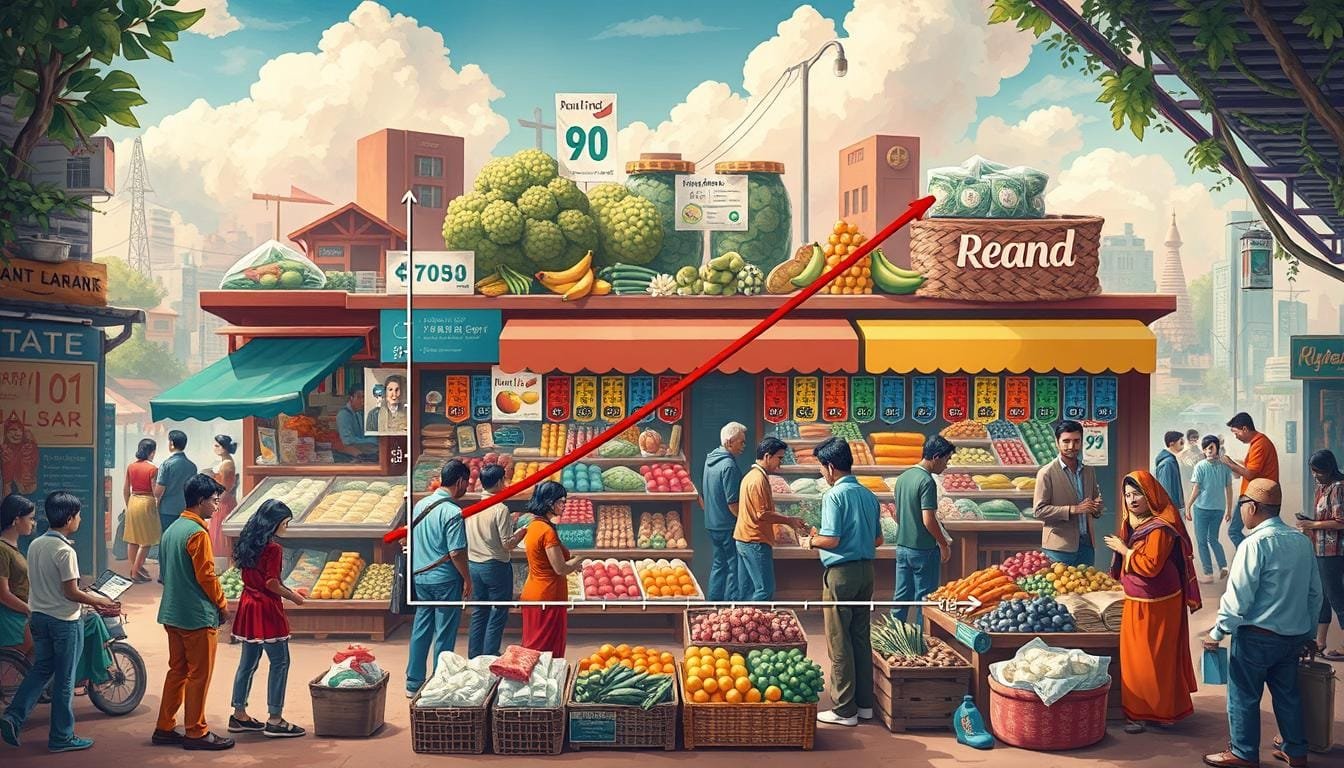Why do people rush to buy a new product, making its price jump high, only to soon lose interest, leading to lower prices? Understanding economic demand helps explain this. It shows how consumer actions affect everything in our economy. This includes how products are priced and when they are launched.
We will explore what drives market demand, including price, income, and trends. We’ll look at key economic theory principles too. This guide is perfect for business owners wanting to predict market changes or students learning about economics. It provides a deep dive into the forces behind demand.
Key Takeaways
- The law of demand indicates an inverse relationship between price and quantity demanded.
- A demand schedule lists the quantities consumers are willing to purchase at different price levels.
- Non-price determinants like income levels and consumer preferences can shift the demand curve.
- The substitution and income effects explain consumer reactions to price changes.
- A linear demand function exemplifies how quantity demanded decreases as price increases.
Introduction to Economic Demand
Getting the hang of what demand means is key in basic economics. Essentially, demand shows how much people want to buy goods and services at different prices. It plays a major role in how market prices change and how goods are sold in our economy.
What is Economic Demand?
Economic demand is not just about choosing to buy something. It’s about being willing and able to purchase at different prices. Imagine TVs only cost $5. Then, many would rush to buy them. But if one TV cost $50,000, few would buy, making it a rare luxury. The link between price and wanting to buy usually goes in opposite ways. Lower prices mean higher demand and the other way around. This idea is crucial to the law of demand, introduced by Adam Smith in 1776.
Importance of Understanding Demand in Economics
It’s critical to understand demand for both shoppers and companies. It affects choices from what we buy to big global economic plans. The demand curve, for example, shows the connection between a product’s price and how much people want it. It helps us see how markets work. The place where supply and demand curves meet is the best price for both makers and buyers. This balance is important for keeping the economy steady. It plays a role in things like government spending and job rates.
Knowing about economics means understanding how changes in demand shake up the market. For instance, more people usually means more demand for stuff, pushing both prices and amounts sold up. But in places like socialist countries, the government sets prices, ignoring supply and demand. This shows us how complex economics can be.
The Factors Influencing Economic Demand
The economic world is driven by many factors that affect how much people buy. Knowing these factors lets us understand why people buy things and how markets move. Let’s look at the main things that change economic demand.
Price of Goods
How much something costs greatly affects if people buy it. The Law of Demand says if something costs more, people buy less of it. For example, if the price goes up from $12 to $16, people might buy 20 units less. When Coke is expensive, people may switch to Pepsi. This shows how changes in the price of one good can affect another similar good.

Consumer Preferences
What people like and want can quickly change demand. Fashion and what celebrities like can make a big difference. Sometimes, a celebrity liking a product can increase its demand by 20%. The time of year can also change what people buy, like how some clothes are more popular in certain seasons. What people want and what is popular play a big role in what they buy.
| Factor | Example | Impact on Demand |
|---|---|---|
| Price of Goods | Price increase from $12 to $16 | Demand decreases from 80 to 60 units |
| Celebrity Endorsements | Product promoted by a celebrity | Up to 20% increase in demand |
| Seasonal Trends | Fashion retail | Up to 40% variation in demand |
| Substitute Goods | Coke vs Pepsi pricing | 7% increase in demand for Pepsi |
Income Levels
How much money people have affects what they can buy, known as the income effect. Most things people buy have a positive link with how much money they make. But, sometimes, more money means buying less of cheaper stuff. For example, people might buy less cheap ground beef. When the economy is good and people have more money, they spend more. But in hard times, they might spend less because they’re worried about their jobs.
Substitutes and Complements
Choosing between similar products affects demand too. If Samsung phones get more expensive, people might buy more iPhones instead. This shows how connected our choices are. Products that go together, like bagels and cream cheese, also have a link. If bagels become 10% more expensive, people might buy 5% less cream cheese. It’s important to understand these links to predict what will happen in the market and make good plans.
Looking at how prices, income, what people want, and how products relate to each other helps us see what drives demand. These insights help companies and those who make policies react better to how people’s buying behavior changes.
What is the Demand in Economics?
To understand demand in economics, we explore the demand curve and its dynamics. We also look into the law of demand. Additionally, the difference between shifts and movements along the demand curve is key. These concepts help analyze the demand curve, assess price elasticity of demand, and identify market equilibrium.
Demand Curve and Its Dynamics
A demand curve shows how the price of a product affects how much people want it. When prices go down, people want more. And if prices go up, they want less.
Demand elasticity is crucial. It shows how changes in price affect demand. For example, if car wax goes from $0.69 to $1.69 and people buy more, it means they see it as better quality.
Law of Demand
The law of demand says if the price goes up, the demand goes down, if other factors stay the same. And if the price drops, more people want to buy the product. This law is central when looking at how prices affect market balance.
George Stigler suggested finding an exception to this law could lead to professional success. It shows how sturdy the law of demand is.
Studies prove this law. A 10% price increase might lead to a 20% dip in demand. In market studies, an elasticity less than one shows demand that doesn’t change much with price. But if elasticity is over one, demand changes a lot with price.

Shifts vs. Movements Along the Demand Curve
There’s a difference between shifts and movements on the demand curve. Price changes cause movements along the curve. For instance, a higher price lowers demand. A lower price raises it.
Shifts in the demand curve happen because of outside factors. More money means the curve shifts right which shows more demand. Less money or higher prices for other goods can make it shift left, lowering demand. Predictions of rising gasoline prices can quickly boost demand for fuel-efficient cars.
- Substitutes and Complements: When the price of a product rises, people might buy alternatives instead. This can lower demand for related products.
- Income Levels: With more money, people usually buy more of normal goods. But they might buy less of inferior goods.
Different factors interact in complex ways on the demand curve. They affect how companies plan and how we study consumer habits.
Real-World Examples of Economic Demand
Let’s understand economic theories with real-life demand examples. We’ll explore how different factors shape consumer choices in various fields. This will make theoretical ideas clear through practical cases.

Technology Sector: Take Apple during a product launch. There’s high competition among buyers for the latest iPhone. This can lead to increased prices. But as time goes by and people look for other options, demand falls. This shows the demand curve’s downward slope. When iPhone X came out, its high price led to fewer sales. Apple had to rethink its strategy to match supply and demand.
Fashion Industry: Zara and H&M drop prices to boost demand during sales. This action illustrates the law of demand. On Black Friday, big discounts drive a surge in buying. This opportunity lets people buy more within their budget.
Food and Groceries: Walmart cuts prices on items like chocolate muffins to increase sales. Lower prices make people buy more, showing how value influences demand. This strategy highlights the balance between supply and demand.
Luxury Goods: Luxury brands like Mercedes-Benz face unique demand curves. A car may start at $200,000. If there are few buyers, reducing the price to $150,000 can help find a balance. This scenario shows how luxury demand is shaped by quality perception, status, and income levels.
Entertainment Industry: Movie ticket sales jump when prices fall, showing how cost impacts demand. Concert tickets follow suit, with price cuts boosting attendance. This reflects the behavior of consumers responding to price changes.
Together, these examples highlight economic demand’s complexity in real situations. They show how market forces can affect what people buy.
Consider the following data-driven insights:
| Scenario | Initial Price | Adjusted Price | Effect on Demand |
|---|---|---|---|
| Luxury Car | $200,000 | $150,000 | Increased Sales |
| Black Friday Sales | Initial Price | Significant Markdowns | Spiked Consumer Purchases |
| Chocolate Muffins | Higher Price | Discounts | Higher Volume of Sales |
| Concert Tickets | $200 | $50 | Increased Attendance |
Conclusion
We’re wrapping things up, and it’s time to reflect on the key points about economic demand we’ve covered. We’ve looked at many factors that affect demand. These include goods prices, what people prefer, and how much money they have. The law of demand taught us that high prices usually mean people want fewer goods.
Understanding the demand curve tells us how price changes affect what people buy. Without changing what people like, price changes move us along the curve. Real-life situations have shown how this knowledge applies outside the classroom. We’ve seen how our choices on what to buy are influenced by other available products and our income.
Getting to grips with economics helps us make smarter decisions. This might be managing our money or looking at the bigger picture of economic policy. Economic demand affects our life, influencing market trends and what we buy. By using what we’ve learned, we gain valuable insights. This helps us understand the economy around us better.
FAQ
What is economic demand?
Economic demand is when people want and can pay for a certain good or service. It’s shaped by price, income, and what consumers like.
Why is understanding demand important in economics?
Knowing about demand helps businesses and officials make smart choices about prices, what to make, and how to use resources. It gives insight into how markets work and what people want.
How does the price of goods influence economic demand?
Price greatly affects how much of a good people want. If a good’s price goes up, fewer people want it. This idea is called the price elasticity of demand.
What role do consumer preferences play in demand?
What people prefer to buy shapes demand. When tastes change, so does demand. This changes how markets work.
How do income levels influence economic demand?
Money that people have affects their buying power. More income usually means more demand, while less income means less demand. This idea is called the income effect.
What are substitutes and complements in economic demand?
Substitutes are items that can replace each other. For example, if coffee gets more expensive, people might buy more tea. Complements are items bought together. Like if phones are cheaper, more phone cases might be sold.
Can you explain the demand curve and its dynamics?
The demand curve shows the price of a good against how much people want it. It goes down from left to right. Lower prices mean more demand. It helps us understand market trends and how to set prices.
What is the law of demand?
The law of demand says that if everything else stays the same, when a good’s price goes up, demand goes down. And when the price goes down, demand goes up.
What are shifts versus movements along the demand curve?
Movement along the curve happens with price changes for a good. But if income or tastes change, the whole demand curve shifts. This means people want more or less of something at every price.
Can you provide real-world examples of economic demand principles?
Yes! Electric cars becoming popular increased demand for lithium batteries. Meanwhile, more people using streaming services has lowered the demand for DVDs. These cases show economic demand principles in action.
